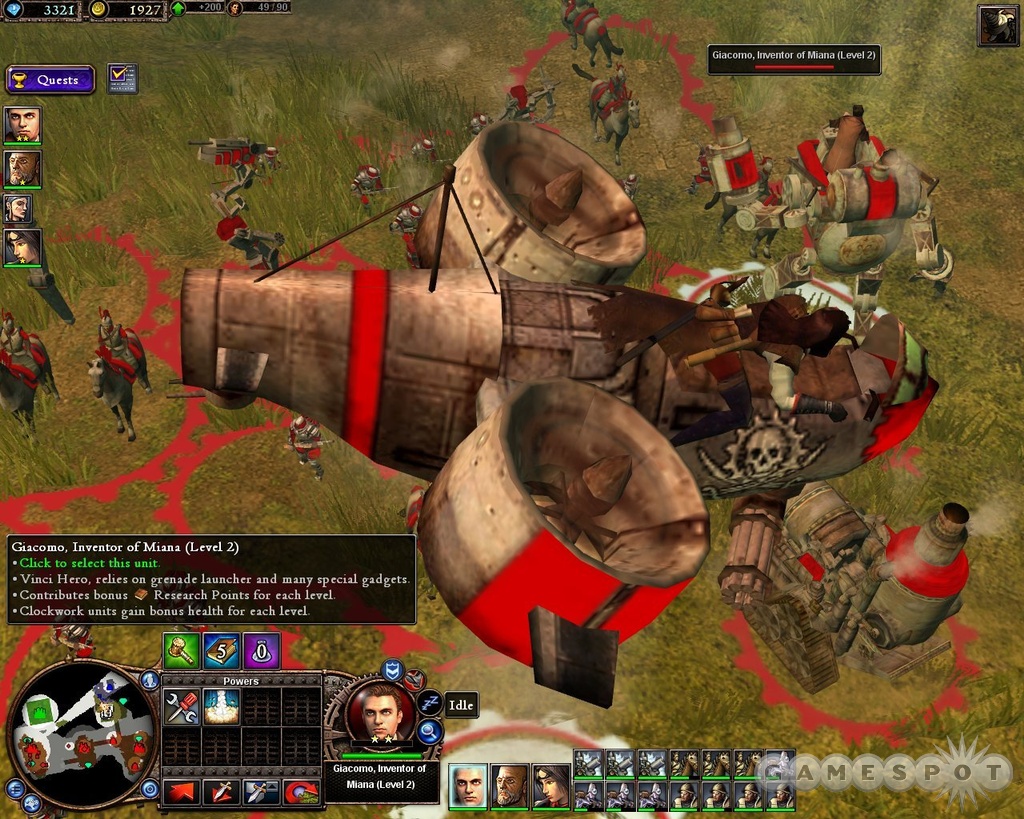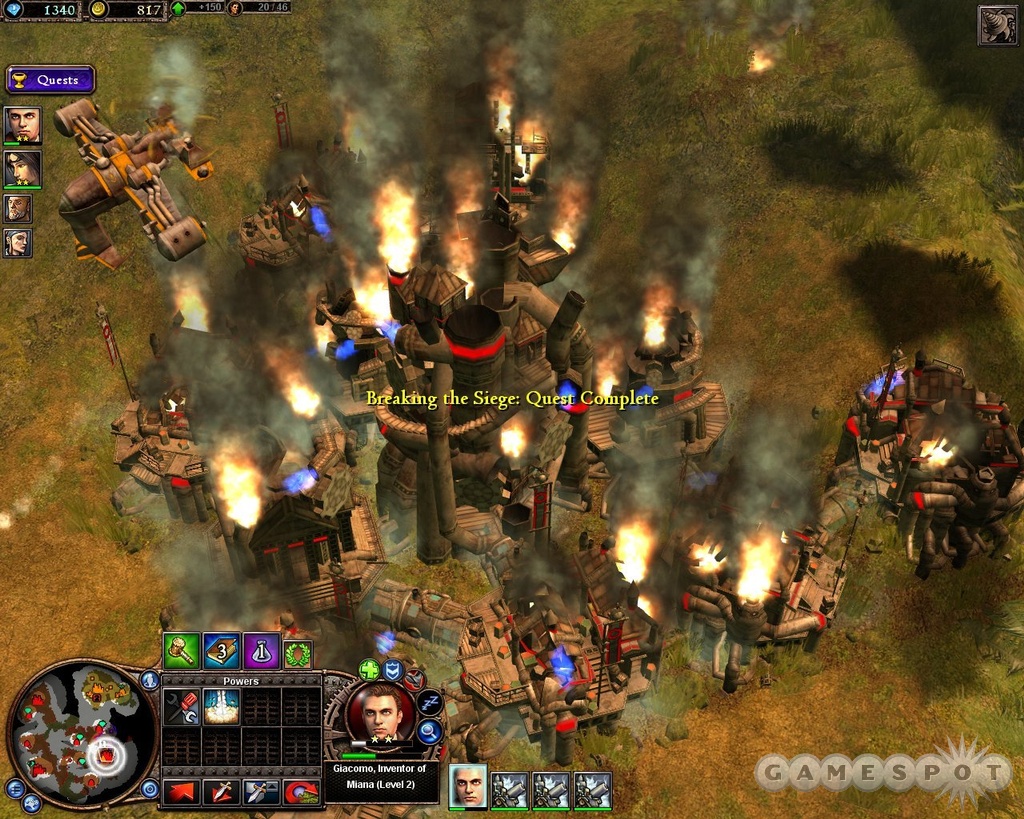High expectations are a curse. While everybody envies developers who make games as great as Rise of Nations, nobody envies them when sequel time comes around. And you can really see why with Rise of Legends. Big Huge Games' follow-up to its instant classic from 2003 is a pretty good RTS, but it is also an awfully familiar one that doesn't bring anything new to the table aside from some snazzy new graphics, a few rule tweaks, and a quirky storyline with three oddball races. After a dozen hours or so of the campaign and noodling around online, the novelty vanishes...along with a fair number of the compelling reasons to keep playing the game.

Story is one of the big reasons why Rise of Legends feels a bit flat. Although the title of the game leads you to expect some kind of Ray Harryhausen-style extravaganza with Greek gods and gorgons, this is not the second coming of Age of Mythology. Instead of rehashing well-worn folklore, Big Huge Games decided to try something new and craft an original setting complete with three unique races and loads of zany units that rework just about every fantasy and science fiction convention out there.
Big Huge Games was obviously trying to manufacture one of those "you got peanut butter in my chocolate!" moments where an off-the-wall combination works out perfectly. The only problem here is that the fantasy and sci-fi doesn't so much blend together as it does clash, at least in the campaign, when a story interferes with taking the races and units on their own not inconsiderable merits. The three races, each fanciful recreations of cultures from disparate eras and far-flung corners of the globe, seem to have been pulled from different RTS games. You've got the steampunk-flavored, quasi Venetian Vinci, who utilize tech derived from the sketches of Leonardo da Vinci, like wobbly gyrocopters and clockwork robots. Then there are the Alin, a civilization of sinister Arabian wizards who battle with magic and fiery efreeti footsoldiers. And finally there are the Cuotl, Mayan-like aliens with E.T. technology such as energy shields and flying saucers.
This wacky mish-mash of real history, Dungeons & Dragons, and Chariots of the Gods is damn hard to warm up to. Each of the civilizations is so offbeat that there are no reference points, no similarities to RTS conventions that you can latch onto and use to dip a toe into the weirdness. The story in the campaign is decidedly convoluted, as well. You're just tossed into the 20-hour, three-part campaign with no preamble aside from a brief conversation about a mysterious artifact that seems to be making people sick. Moments later, you're leading conquistadors and clockwork robots into battle against mechanical spiders and glass monsters. Events pile one on top of the other. There's an evil doge wreaking havoc, some weird unknown force supporting rebels, a hot pirate babe, and, well, it's even harder to make sense of all this stuff on paper as it is when you're experiencing it in person. Oh, and the ending pretty much screams "expansion pack coming in Q1 2007."
Campaigns themselves blend the conquer the world mode of the original Rise of Nations with stereotypical RTS scenarios. As before, you move your forces on a map to accomplish objectives and conquer provinces. This affords some freedom of movement, in that you can generally choose between two or three regions to attack at any given moment in the game. Repetition is a bit of an issue, though. In most provinces, you arrive with your stock troops. Then you build a base complete with barracks, factories, and the like. Then you develop wealth through creating caravans (reactors in the case of the Cuotl) and collect the glowing blue rock resource called timonium. Finally, you crank out an army and sally forth to assault enemy armies and strongholds. Way too many maps force you to rebuild the same base and deal with nothing but "conquer all these cities" objectives.
There isn't anything here that you haven't seen before, especially if you've played Rise of Nations. Play is almost identical in character to the earlier game. The streamlined interface and unit selection and innovative border system where you can assimilate land by developing cities are carried over into the new game intact. Ages have been dropped, as has a lot of the tech research, to befit the nonhistorical fantasy setting, and heroes have been added, but this doesn't alter the feel of the game much.
With that said, Rise of Legends is more than just an unusual retread. Without the encumbrance of the off-putting story, which forces you to constantly question what the deal is with these steampunk Venetians, magic Arabs, and Mayan aliens, you can appreciate the races for their eccentricity and the way in which they complement one another. In single-player or multiplayer skirmish play, all three are fascinating. Buildings and units are very different than those in the typical RTS, and the races balance just about perfectly. The Vinci start strong, and are probably the best overall race for newbies thanks to the strength of their early clockwork men and steam cannons. But both the Alin and the Cuotl get much more potent as time goes on. Work on long-term plans to build powerhouse units like the Alin glass dragons and the Cuotl sun idols and you've got a good shot at eventually smashing those clockwork creations like they were toys.

It doesn't appear as though the artificial intelligence quite knows how to handle the specific, unique strategies necessary to get the most out of each race, however. In solo skirmish games against the computer, the AI didn't seem to advance promptly or attack sensibly. While it always did a great job of setting up defenses around its capital city, which meant titanic battles to end games, it tended to crank out a lot of easily destroyed, low-level shock troops and throw them at well-defended points again and again. Set up some turret defenses, like the Cuotl's obelisk lightning towers, near key locations like timonium deposits, and AI units could be guaranteed to flock to them like insects to backyard bug zappers.
Going online doesn't seem to be an answer to these skirmish problems, either--at least not yet. The third-party application-based matching system left a lot to be desired in the week after Rise of Legends hit stores. Few people seemed to be online playing, and it was difficult to get into matches even when you could find willing opponents, as odd drops and disconnects were common. The first week is always the roughest when it comes to taking an RTS online, though, so don't write off the multiplayer here just yet.
Great art design almost makes you forget about some of these issues. You can just sit and gawk at the Vinci's buildings and units in action, as they look like steam-powered constructs made out of Tinkertoys, with turning wheels and pistons everywhere. Alin cities float, and have those curvy towers that look like something out of the 1,001 Arabian Nights. Their fiery afreeti are something to behold when they attack en masse, too. The Cuotl are a bizarre blend of old and new, with industrial structures that give off a deep red glow and units that blend Mayan mythology with futuristic technology. There is nothing quite like springing a pack of hissing, robotic death snakes backed by a phalanx of Mayan warriors with lasers on an unsuspecting foe.
All of this detail does cause a few technical issues, though. Slowdown is a factor in large-scale battles, especially during the climax of city sieges when big fortresses catch fire and start to smoke. The game runs reasonably well on a midgrade system, but the game's all-new graphics engine definitely has some performance kinks that need working out.

Audio is another problem. It either wasn't finished before the code was finalized, or Big Huge Games has developed an appreciation for the sounds of silence. Battle effects are barely there. Barrages of gunfire and explosions in the midst of a city siege are almost inaudible, even with the volume cranked. This takes a lot of the excitement out of battles, and actually makes things a bit eerie, particularly when a building explodes into flaming rubble with barely a peep aside from the orchestral drone of the musical soundtrack.
Since Rise of Nations was so fantastic and innovative, it's only natural to anticipate that Rise of Legends would be similarly ground-breaking. That it isn't is disappointing. But those looking for a quirky RTS with great races and well-balanced units--that also somehow manages to pack all of that into a more-of-the-same design--will find a lot here to like, as long as they're not too hung-up on great storytelling.
